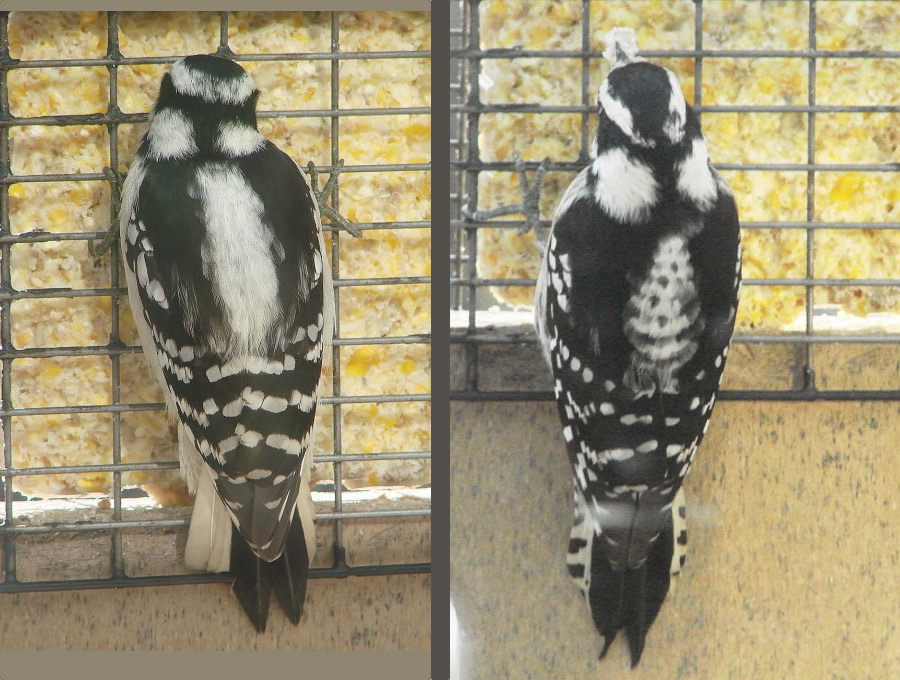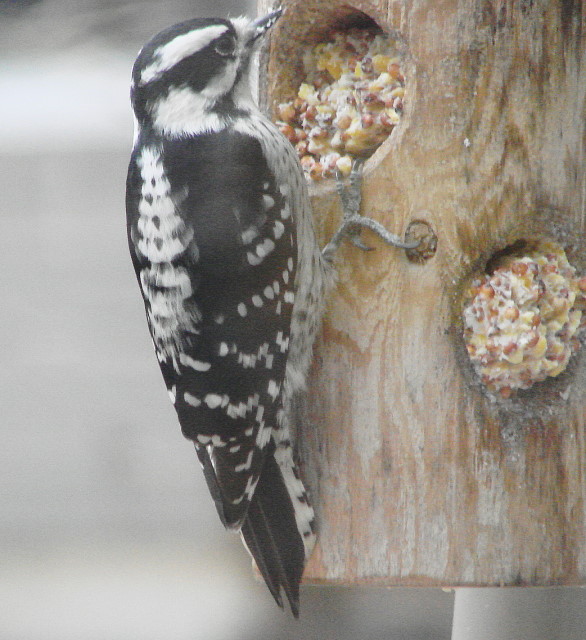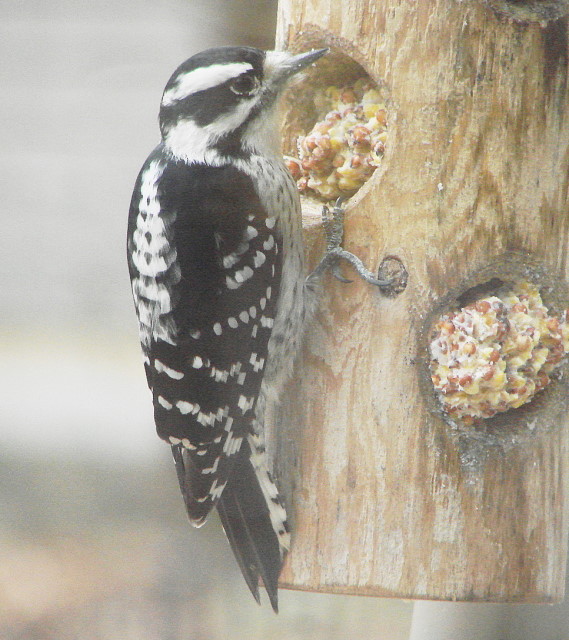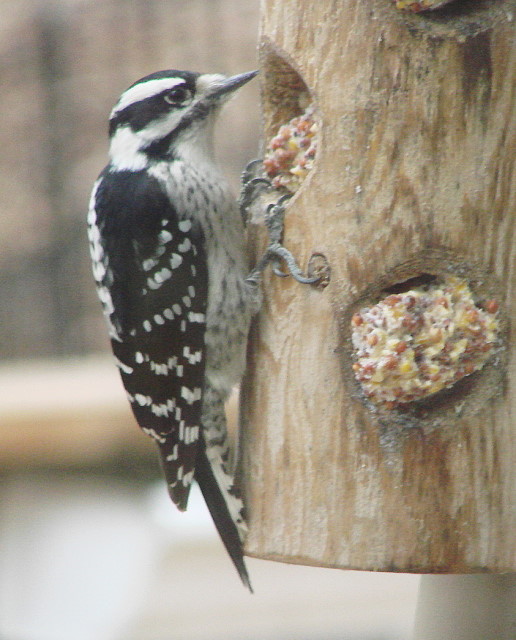
In early December 2016, David Pierce of Wildwood, Missouri, noticed an odd woodpecker at his feeder and took some really nice photos. I always marvel at the path these kinds of stories follow: Dave had to be looking carefully enough to notice the slight differences in this bird, make the effort to take some good quality photos, and then post those photos and call them to the attention of the birding community, starting the discussion. It’s the kind of curiosity and perseverance that advances our collective understanding and leads to discoveries all over the world.
By size, shape, and head pattern it’s definitely a Downy Woodpecker, but it has a lot of odd details in the plumage:
- dark barring on the normally white back
- smaller white patch on the back
- dark streaks on the underparts (see more photos below)
- much bolder dark bars than normal on the outer tail feathers
- reduced white spots on the wings
The common thread of these features is that they all involve more black than a typical Eastern Downy Woodpecker.
I think the simple answer for this bird’s anomalies is some form of melanism, a general excess of dark pigment. Melanism is a lot less frequent than albinism (a reduction or absence of dark pigment) and this case is even more unusual in that it has produced a very intricate pattern of dark markings. Most examples of melanism in birds involve large parts of the bird being blackish or reddish-brown.
There is no hybrid combination that could explain these markings, and nothing else that looks wrong for Downy Woodpecker. And it’s interesting that this Eastern Downy Woodpecker, with excess black pigment, didn’t just turn out like a Western Downy Woodpecker, which shows broader black stripes and narrower white stripes on the head, less white in the wings, but still a clean whitish back and underparts.
This is the first record I’ve ever encountered of a bird like this, and I will be very interested to know if anyone reading this has seen a similar Downy Woodpecker.



Thanks to David Pierce for noticing the bird, and for allowing the use of his photos, his Flickr page is here


Can’t most of these features be explained by a Ladder-backed x Downy hybrid? A quick search turned up some similar looking individuals that were labeled as such:
https://www.flickr.com/photos/bonxie88/17151777122
https://www.flickr.com/photos/gregpage/13411007494
https://ebird.org/media/catalog?includeUnconfirmed=false&date.beginMonth=1&searchField=species&hotspot=&date.beginYear=1900&date.monthRange=M1TO12&date.endYear=2017&start=0&count=30&mediaType=Audio&mediaType=Photo&mediaType=Video&sort=upload_date_desc&hotspotCode=&userId=&taxonCode=x00801&q=Ladder-backed%20x%20Downy%20Woodpecker%20(hybrid)%20-%20Picoides%20scalaris%20x%20pubescens&view=Gallery®ionCode=&species=Ladder-backed%20x%20Downy%20Woodpecker%20(hybrid)%20-%20Picoides%20scalaris%20x%20pubescens&action=show&date.yearRange=YALL&date.endMonth=12®ion=&user=
That’s true, Downy Woodpecker X Ladder-backed Woodpecker is probably the closest match in a hybrid, so definitely worth considering. I think the photos you link to are all of the same individual bird in Galveston, Texas. There is only one other report of an apparent hybrid, a sight record from Austin, Texas.
In photos the Galveston bird looks perfectly intermediate between the two species with white surrounding the dark cheek, and broad white bars on the back. The Missouri bird shows features that are not intermediate, instead more like Downy Woodpecker and even darker: dark cheek connected to the dark nape, white of the back more restricted with a wider band of solid black on each side, smaller white wing spots, more streaks below and more dark bars on the tail than typical of either species.
I think all of that argues against a hybrid, but still open to other opinions.
Has a Downy x American Three-toed Woodpecker been considered?
Fourth digit seems small but I think that’s typical for Downy.
I won’t speculate on how such a bird would get to Missouri, either.
As far as I know there have never been any hybrids reported involving either American Three-toed Woodpecker or Black-backed Woodpecker. The dark markings on the back and the flanks on this bird do suggest American Three-toed Woodpecker, but I would expect to see a lot of other differences on a hybrid: narrower white head stripes, different shape and size, etc. I still think this is best explained as a Downy Woodpecker with a little bit of extra black all over.
I had a similar bird visit my feeder at Putnam Lake, NY for several years. He had a red patch on the back of his head, but so many black features on his body that he looked like he lived in a chimney. I named him “Pig Pen” after the Charles Schultz character. But someone must have found him attractive, because one year I saw him bring a youngster to the feeder several times. Unfortunately, I never had a camera handy when he showed up. To the best of my knowledge, the Ladder-Backs, Three-Toes, and Black-Backs’ ranges are nowhere near the lower Hudson valley.
I just had what I thought was a male Downy at a feeder, but there was no white back. His red patch was more auburn than bright red. His back looked more like the Ladder Back. I’m also in the Hudson Valley. Cold Spring, NY.
We have a chocolate Downy Woodpecker coming to our feeder in Grosse Ile Michigan.
His breast and back of his head and cheeks are a reddish-brown color. He has only a few
black markings on his back. Any ideas on this bird? Melanistic? Pacific Northwest?
I live in Savage Mn. and I am watching one that matches your description, which prompted me to do this search. Downy”s are very frequent visitors to our suet feeder and this is the first time I’ve noticed this coloration. What got my attention was that instead of white his chest is a light brown look. It is a male.
Here is a link to the picture of our Chocolate Downy:
https://www.flickr.com/photos/142534745@N06/
Hi Rosemary, Woodpeckers sometimes show dark sooty, brown, or yellow color on the underside, and I generally attribute that to staining from wood. Since they are often in contact with wood, and spend the night in tree cavities resting on a bed of wood or wood chips, I think it’s easy for some of them to pick up some coloration from that. The bird in your photo is consistent with that – colored on the underparts and not on the back.
Good Birding,
David
Pingback: Blog Birding #302 « ABA Blog
The bird looks consistent with Red-cockaded x Downy. The range of these birds suggests this is reasonable as well. Has this been considered?
I wonder about the Red-cockaded x Downy also. I have a very similar-looking bird I’ve noticed visiting my suet feeder since April. I have a lot of photos, but here’s what I’d posted to eBird.
http://ebird.org/ebird/view/checklist?subID=S28738051
Hi Karen, Wow, your photos are strikingly similar to the Missouri bird, and must represent the same condition. The black line on the back of the head could be enhanced as part of the overall increase in dark markings.
I did consider a Red-cockaded hybrid, but the head pattern is so fundamentally different, with black and white in different places, and this bird shows a perfectly normal Downy Woodpecker pattern. I would expect a hybrid to show at least some unusual feature of head pattern.
I’m seeing Downy Woodpeckers like this again this winter. I didn’t see them over the summer.
On a completely different vein, and long after the last comments on this thread, I would like to share pictures of a Pine Warbler myself and some other birders on the Southern Lake Norman Count found this past weekend. The Pine Warbler had a yellowish cheek patch and white flecking on the nape. I’m guessing the bird is partially leucistic?? Link to the eBird checklist (with a couple of photos): http://ebird.org/ebird/view/checklist/S41165912. Thanks!
Thanks for sharing that photo, Matt. Yes, it is a leucistic (or partial albino) Pine Warbler. The absence of melanin on the cheeks leaves the feathers white with yellow pigment there. That’s a frequent occurrence with albinism – most olive-green color in birds is a combination of melanin (gray) and carotenoids (yellow). The lack of melanin allows the yellow colors to show.
Thanks for your reply. I certainly learned something new!
I just spotted this type bird on my backyard finch feeders, and decided to try to look it up not knowing what type bird this was. Unusually it seemed to be a woodpecker of sorts with a very halfbreed looking black and white mut colorings. Smaller like a finch but wider and definite black and white color distinctions at varying places. not stripes of spotted necessarily, but just a black white mix all over, making a definite wood pecking type movement on my dried-out seed bags.
Mostly like a melanistic wood pecker. I don’t stuty birds, so Is this common to Indiana?
Beth, I live in Florida and just saw the same thing. Small, finch like woodpecker, with blotches of black and white. In my fifty years I have never seen a bird like this. It’s call is the same as a downy, and I could hear it’s mate responding from the back yard. None of the pictures I’ve seen resemble this bird exactly as it was more white than black without the cascading mix of color. Just patches of black and white, and very small. Four inches max.
I took some shots of a Downey woodpecker at my suet feeder yesterday that had a gray/brown belly and neck, and a darker back! Haven’t uploaded them to my computer yet, but got some great pics. I’ve been wondering, too!
I have had a sooty Downy show up now for the last 2 days. It is about 3/4 of an inch smaller than the other Downies nearby. He is all black and gray…not white. I’d love to share the pictures.
I saw a similar bird to the photo and am glad this post is here. I’m in Plymouth MI. My local bird is mostly black and white with a beige-y belly, which I’ll attribute to the wood tannins, noted after reading this post. It does not have red markings on its head. I thought it was a longer, roundish (ahem, well-fed) black-capped chickadee at first. When I was it was acting like a woodpecker, I went on the search for what kind of bird it might be. I got a REALLY good look at it – it was less than 4 feet away – and surprised me by pecking at my outdoor furniture, while I was right there!, for about 30 seconds before it decided to move on. Would it be safe to guess its a melanistic downy woodpecker? Do the adults take some time to develop red marks (if they’re going to develop them)? Do males and females sometimes both have red marks?
I took a picture two days ago of a male Downey with brown wingtips. Actually the lower half of his wings when he is resting are a reddish brown. I live in Pennsylvania. Any ideas? I would be happy to share a picture but I’m not sure how to.
Frissy518 @ yahoo.com.
Thanks
I took a picture two days ago of a male Downey with brown wingtips. Actually the lower half of his wings when he is resting are a reddish brown. I live in Pennsylvania. Any ideas? I would be happy to share a picture but I’m not sure how to…..
Frissy518 @ yahoo.com.
Thanks
I had one of these visit my feeder today (St. Louis, MO)! Below is a link to the best quality picture I could grab. I was glad to find this post to identify it — thank you!
https://photos.app.goo.gl/RRsLMdJKW5x3mEiw9
I live in a suburb of Kansas City, Missouri and have several female Downies, eating at my feeders on a daily basis, that look identical to the Downey in this image. Strangely, none of the males have this unusual pattern. Not certain if this is a coincidence or not?
We have one or two that come here to our feeder daily. Exactly the same as the ones shown above. The one like the one the left was just here. WE are in Val-des-monts, Quebec, Canada. Thank you for your posing of these beauties. Juanita
I arrived here looking for information about a woodpecker that was at my feeders today. Since you were interested in hearing from anyone with a similar encounter, here is my observation on iNaturalist:
https://inaturalist.ca/observations/197008998
This one is missing completely the white cheek stripes and the nape. Very dark markings on back and underside of tail.
I’d be very interested in your take on whether it is a melanistic Downy or perhaps a hybrid.
Hi Peter, Wow! That is a a stunning bird! Thanks for sharing. I think melanism is the answer, with many parts being more black than usual, especially the head but also the back and breast, and the black bars in the tail are larger than usual. There is no indication of hybridization that I can see.
It has returned for 2025! https://inaturalist.ca/observations/260108627
I’m not sure where you are more active, iNat or here, so I’m leaving this comment in both places.
I think you should get an ornithologist or other expert to your property to observe this bird. The vast majority of melanism cases present as a consistent dark wash over the entire bird, or a specific pigmented section.
I think a Downy x Black-backed woodpecker hybrid should be considered since there is possibility for range overlap in this area. If it is the first of its kind, that would be an amazing find!
I have a melanistic Downy that has been visiting my bird feeders for several months here in Southwest Connecticut. I have a number of Downy Woodpeckers that visit my feeders, but this is the only one that shows melanism (interestingly I have also had melanistic garter snakes in the yard). When I first saw him I wondered what I was looking at, whether he had somehow been covered in dirt, but he has been visiting for months and there’s no doubt that this is his natural coloration. I managed to get a few photographs; they aren’t the best quality because I had to shoot through the window (he’s very shy) but these are clear enough to show him in some detail.
Hi Tom, Very interesting! My first thought is that this could be staining or dirt, as the dark color is only on the underside while the wings look normally black-and-white. Woodpeckers often get discolored on the breast as they come in contact with wood in a nest hole. That answer is less likely since you say this bird has looked the same for months, but those feathers will only be molted once a year in late summer. I would keep watching it to see if there is any change over time, and if you can get clearer photos that might shed some light.
I was looking for information on melanistic downy woodpecker, since we have had this little Cinderella visiting our suet feeder this whole winter. All larger areas of white are gray, with only the spots on wings staying white. This is in the central lakes area of Minnesota. We also have a lot of black squirrels, the melanistic form of the gray squirrel, so it made me think this woodpecker may also be a result of melanism.
I’ve had a melanistic downy woodpecker this spring who is almost all black. His red patch is visible and some of the wing markings. He comes with a female who has regular downy markings. I live in Carthage NY.
Both my Merlin app and the folks at Cornell have identified them as downys.
According to Birds of the World, Downy x Nuttall’s has been recorded on many occasions, and this bird looks identical to many of the female birds recorded on the Macaulay Library page for this hybrid. Typically melanism presents like a dark filter/wash over a bird’s body, or over a specific pigment so the fact that this is such a consistent pattern of shrunk white patches and the white is unaffected makes me doubt melanism.
https://search.macaulaylibrary.org/catalog?taxonCode=x00662&mediaType=photo&sort=rating_rank_desc